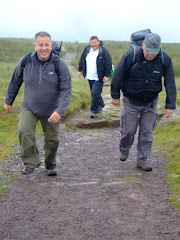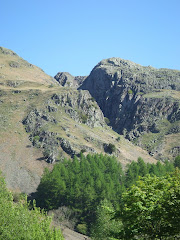
The drive through the deserted village of Longtown at 11.00am could only mean one thing - all of the inhabitants were watching the Royal Wedding - the event that we had decided to avoid. So it was a major surprise when we arrived at the car park to find it was already full!
I don't think that I've ever been asked whether I'm a botanist before but that was the strange question posed by a very academic looking lady with a posh voice as we changed our boots to start the walk.

The Black Hill itself rises just north of Longtown and west of the village of Craswall, near the Wales/England border. It is known locally as the 'Cat's Back' as when viewed from Herefordshire it looks like a crouching cat ready to pounce.

After the initial steep climb we encountered a tremendous 2 kilometre narrow ridge with the Olchon Valley on the western side and Golden Valley to the eastern flank. This was a really stunning stretch of mountain ridgeway.

Unfortunately, it was windy and cold after the really warm weather of the last few weeks.
 We soon reached the first trig. point at Black Hill (640 metres) and then headed north west to join Offa's Dyke Path for the two kilometre walk to the trig. point at Hay Bluff (677 metres). Our second Nuttall summit of the day (both on the English side of the border).
We soon reached the first trig. point at Black Hill (640 metres) and then headed north west to join Offa's Dyke Path for the two kilometre walk to the trig. point at Hay Bluff (677 metres). Our second Nuttall summit of the day (both on the English side of the border).Although the visibility was patchy the views down to the car park near the stone circle at the foot of the Bluff were amazing.

After eating our lunch we started the trek south on Offa's Dyke Path toward Hatterall Ridge. A distinctive path marked on the OS map was rather in-distinctive in reality and we needed to eventually head east at the stone marker at the crossroads to the Olchon Valley and Capel-Y-Ffin. At this point the weather conditions started to improve and the spectacular views began to open up around us.

The decent to the valley floor was an almost vertical drop of nearly 1,000 feet and we commented that we were really pleased that we did not have to climb this at the end of the walk as we passed someone who would shortly be on their way up. We crossed the Olchon Brook and walked through Black Hill Farm en route to the starting point.
After the main cultural spot of the day - a visit to the remains of Longtown Castle, which was built in the 13th Century to keep the maurading Celts out of England - it was a brief stop at the Crown Inn for liquid refreshments before sneaking back over the border into the Principality at Pandy.
The walk was 13.5 kilometres and took four hours thirty minutes including half an hour for lunch and a scheduled tea break.
Photographs taken on this walk can be viewed here. Select 'slide-show' for automated viewing.
Bruce Chatwin used the Black Hill as the setting for his novel 'On the Black Hill'.



























.JPG)
.JPG)
.JPG)
.JPG)
.JPG)
.JPG)
.JPG)











































